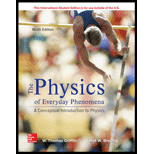
Concept explainers
A guitar string has an overall length of 1.25 m and a total mass of 1.0 g (0.001 kg) before it is strung on the guitar. Once on the guitar, however, there is a distance of 69 cm between its fixed end points. It is tightened to a tension of 74 N.
a. What is the mass per unit of length of this string?
b. What is the wave speed for waves on the tightened string?
c. What is the wavelength of the traveling waves that interfere to form the fundamental standing wave (nodes just at either end) for this string?
d. What is the frequency of the fundamental wave?
e. What are the wavelength and frequency of the next harmonic (with a node in the middle of the string)?
(a)
The mass per unit length of the string.
Answer to Problem 2SP
The mass per unit length of the string is
Explanation of Solution
Given Info: The length of the string is
Write the expression to calculate the mass per unit length of the string.
Here,
L is the length of the string
m is the mass of the string
Substitute
Conclusion:
Therefore, the mass per unit length of the string is
(b)
The wave speed.
Answer to Problem 2SP
The wave speed is
Explanation of Solution
Given Info: The mass per unit length of the string is
Write the formula to calculate the wave speed.
Here,
v is the wave speed
F is the tension on the string
Substitute
Conclusion:
Therefore, the wave speed is
(c)
The wavelength of the travelling wave.
Answer to Problem 2SP
The wavelength is
Explanation of Solution
Given Info: The distance between two end is
Write the expression to calculate the wavelength.
Here,
l is the distance between two ends
Substitute
Conclusion:
Therefore, the wavelength is
(d)
The frequency of the standing wave.
Answer to Problem 2SP
The frequency of the standing wave is
Explanation of Solution
Given Info: The wavelength of the standing wave is The longest possible wavelength is
Write the expression to calculate the speed of the sound wave.
Here,
f is the frequency of the sound wave
Substitute
Conclusion:
Therefore, the frequency of the standing wave is
(e)
The frequency and wavelength of the next harmonic wave.
Answer to Problem 2SP
The frequency of the second harmonic wave is
Explanation of Solution
Given Info: The distance between two end is
Write the formula to calculate the wavelength of the second harmonic.
Here,
Substitute
Write the expression to calculate the speed of the sound wave.
Here,
Substitute
Conclusion:
Therefore, the frequency of the second harmonic wave is
Want to see more full solutions like this?
Chapter 15 Solutions
Physics of Everyday Phenomena
- Lab 8 Part 3 PHET Wave Interface simulation. I am having trouble with this part of the lab.arrow_forwardMick and Rick are twins born on Earth in the year 2175. Rick grows up to be an Earth-bound robotics technician while Mick becomes an intergalactic astronaut. Mick leaves the Earth on his first space mission in the year 2200 and travels, according to his clock, for 10 years at a speed of 0.75c. Unfortunately, at this point in his journey, the structure of his ship undergoes mechanical breakdown and the ship explodes. How old is Rick when his brother dies?arrow_forwardHi, I have canceled, why did you charge me again?arrow_forward
 Glencoe Physics: Principles and Problems, Student...PhysicsISBN:9780078807213Author:Paul W. ZitzewitzPublisher:Glencoe/McGraw-Hill
Glencoe Physics: Principles and Problems, Student...PhysicsISBN:9780078807213Author:Paul W. ZitzewitzPublisher:Glencoe/McGraw-Hill University Physics Volume 1PhysicsISBN:9781938168277Author:William Moebs, Samuel J. Ling, Jeff SannyPublisher:OpenStax - Rice University
University Physics Volume 1PhysicsISBN:9781938168277Author:William Moebs, Samuel J. Ling, Jeff SannyPublisher:OpenStax - Rice University Physics for Scientists and Engineers: Foundations...PhysicsISBN:9781133939146Author:Katz, Debora M.Publisher:Cengage Learning
Physics for Scientists and Engineers: Foundations...PhysicsISBN:9781133939146Author:Katz, Debora M.Publisher:Cengage Learning Principles of Physics: A Calculus-Based TextPhysicsISBN:9781133104261Author:Raymond A. Serway, John W. JewettPublisher:Cengage Learning
Principles of Physics: A Calculus-Based TextPhysicsISBN:9781133104261Author:Raymond A. Serway, John W. JewettPublisher:Cengage Learning
 College PhysicsPhysicsISBN:9781938168000Author:Paul Peter Urone, Roger HinrichsPublisher:OpenStax College
College PhysicsPhysicsISBN:9781938168000Author:Paul Peter Urone, Roger HinrichsPublisher:OpenStax College





